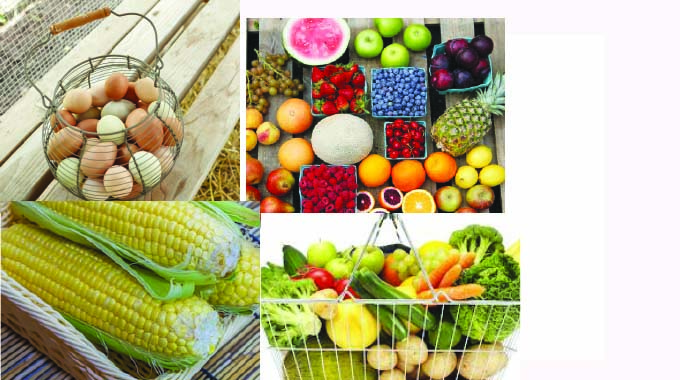Balance in African food ecosystems

Charles Dhewa Correspondent
While it may not be the mandate of development organisations to build manufacturing industries in developing countries, pouring billions of dollars in agricultural production is not lifting people out of poverty.
For every $1 billion invested in agricultural production, another $1 billion should be invested in agro-processing and other value added services to reduce losses and generate sustainable employment.
Synergies between agriculture and other socio-economic systems
The structure of food systems in many African countries continues to be influenced by an enduring colonial legacy. For instance, a key feature of most sub-Saharan African countries has been a dual economy characterised by rural and urban economies, with the rural economy dominated by subsistence production.
Instead of just concentrating on few staple commodities like maize, meat, milk and wheat, each country should be able to regularly map its agriculture landscape as part of a broader socio-economic context.
That is how important overarching principles can be teased out from looking at the entire food ecosystem in terms of where it is coming from, current status and future direction.
For a long time, African rural areas have had their own food basket confined to basics like small grains and tubers like yams whose nutritional knowledge is rooted in local tradition.
Exotic commodities like cabbages, onion and tomatoes were recent additions to traditional food systems. Tastes would only change if somebody went to a city where consumption patterns were driven by what was available in urban areas.
Increasingly, cities were ( and have remained) the demand side of processed agricultural products like packaged maize meal, cooking oil, slaughtered cattle or chickens, with most products found in shops. To a large extent, the urban economy was an industrial economy focusing on processing and manufacturing of different commodities.
From a consumption perspective, rural consumers would eat processed products like bread or baked beans during the festive season like Christmas holidays.
That is how rural consumers acquired new tastes for processed foods like jam, margarine, tinned beef and exotic fruits such as apples and oranges, brought by relatives who worked and lived in cities.
On the other hand, in countries like Kenya, Zambia, Zimbabwe and South Africa, colonialism created a separate economy in the form of large scale farms, neither rural nor completely urban.
This economy produced huge volumes of agricultural commodities for the manufacturing industry and exports. Most commodities produced by large-scale farmers went to processing and manufacturing industries in cities from where finished products would be sold in retail shops and supermarkets.
Large farms also produced non-food commodities like flowers which were exported for foreign currency, enabling the country to trade with other countries.
Responses to a disruptive economy
Economic Structural Adjustment Programmes (ESAP), a few decades ago, triggered the birth of the Small and Medium Enterprises (SMEs) sector as those retrenched from large manufacturing industries used their exit packages and pensions to set up new business.
As employees left formal employment to start their own businesses, experience, knowledge and skills were transferred from large industries to the SME economy. Different classes of people took their passion, capabilities and skills into the SME sector — constituting a new business class.
On the other hand, the expansion of formal education in the form of schools, colleges and universities increased literacy levels. It is known that literacy plays a central role in creating social classes and that meant formal education produced lecturers, engineers, managers, business owners and others, with different food tastes and needs.
Although ESAP was blamed for destroying some African economies, it gave birth to new opportunities for people to innovate and create new enterprises. During the same period, investments in infrastructure like rural electrification supported the expansion of SMEs into previously marginalised rural areas.
Decentralisation of knowledge, tastes and consumption patterns
The emergence and growth of SMEs has significantly defined consumption patterns. Some SMEs have taken the role of manufacturing, processing and value addition. There has been marked decentralisation of knowledge, skills and business activities to smaller towns, growth points and business centres. This transition has happened together with consumption patterns as food systems have followed the SME sector wherever it blossoms — integrating consumption patterns in the SME ecosystem.
Prior to the evolution of the SME sector, companies and industries used to define consumption patterns of the working class through canteens where menus were set to meet demand during working hours.
At least 90 percent of working class people spent much time at work where they did not have much choice in terms of food compared to SMEs where food choices are broader and flexible.
In countries like Zimbabwe where land reforms have happened, there has been an unbundling of knowledge and skills previously confined to farms. Food production patterns have changed based on knowledge, skills and resource capabilities. As smallholder farmers respond to unpredictable climate change, they grow short cycle crops, most of which are part of horticulture.
Changes in food markets
Previously, food markets were dominated by supermarkets and food outlets, catering for the upper class and hotels. The working class was catered for by small shops and established markets stalls like vegetable markets set up by municipalities in high density areas. On the other hand, the greater population of people stayed in rural areas and rarely came to cities.
Following ESAP and the growth of the SME sector, there has been a marked expansion of informal markets, located close to the SME sector. These food markets have evolved to save all classes of consumers ranging from low income to upper class. Informal markets have become part of the new economy with a broader food basket. Each African country has more than 50 food commodities comprising fruits, tubers, vegetables, legumes and field crops for different classes within the sector and their households.
In addition, while in the past, demand for food was defined by month-end, in the SME sector money circulates every day and that influences consumption habits. This means production and supply have to be consistent in order to meet these new needs. The informal market has to meet the demands of 70 percent of the SME working class from which demand is consistent for 80 percent of the time. The substitutability of commodities is no longer defined by levels of income but by consumer tastes and preferences as well as nutrition and health consciousness.
Consumers are becoming aware that lacking specific nutrients can become costly in the form of family members seeking medical attention due to deficiencies in specific nutrients and vitamins. That is why most households are now paying attention to what is in the food basket. The market has responded consumers get something within their income. This is visible through different measurements and grades. Supply has also responded to this consistent demand for different food commodities.
Enduring gaps
Big issues in African food systems include the fact that consumption patterns remain uncodified by different emerging consumer classes, age, income, location, income, wages, work types and other determinants.
Knowing the number and unique characteristics of existing consumer classes should inform each country’s nutrition basket and entire agriculture sector.
Policy makers and development agencies will also become aware of the extent to which, by continuously promoting maize in the face of changing consumption patterns, they are earning the correct Return on Investment (ROI). Addressing such issues will inform agricultural policies and practices in ways that sustain farming as a business.
In addition, requirements of the expanding SME economy should inform agricultural support in the form of hand-outs, training and infrastructure rehabilitation like irrigation schemes. Critical questions to be answered include:
What is the relationship between informal markets, supermarkets, hotels and regional markets?
Where are hotels sourcing food? Are the markets competing, complementing or duplicating each other?
What are the value chain nodes within markets? For instance within the processing industry, who are the micro-processors, medium processors and large processors? Are they competing or adding value to each other?
On the production side, what is the relationship between different classes of farmers like communal, resettled and large scale commercial farmers? Are they competing or adding value? Who is growing what and for which market? Production and supply patterns cannot continue to function in an ad hoc manner.
Articulating value chains within value chain nodes will enable traceability and ensure food safety, which are pre-requisites in an integrated global economy.
[email protected] / [email protected] / [email protected]: www.emkambo.co.zw / www.knowledgetransafrica.com/eMkambo Call Centre: 0771 859000-5/ 0716 331140-5 / 0739 866 343-6










Comments